Views :
1,125





3Dprinting (172) A.I. (664) animation (335) blender (194) colour (225) commercials (46) composition (150) cool (358) design (627) Featured (65) hardware (302) IOS (109) jokes (134) lighting (278) modeling (116) music (183) photogrammetry (171) photography (744) production (1233) python (84) quotes (485) reference (305) software (1319) trailers (295) ves (522) VR (219)
Author: pIXELsHAM.com
-
Space bodies’ components and light spectroscopy
www.plutorules.com/page-111-space-rocks.html
This help’s us understand the composition of components in/on solar system bodies.
Dips in the observed light spectrum, also known as, lines of absorption occur as gasses absorb energy from light at specific points along the light spectrum.
These dips or darkened zones (lines of absorption) leave a finger print which identify elements and compounds.
In this image the dark absorption bands appear as lines of emission which occur as the result of emitted not reflected (absorbed) light.
Lines of absorption
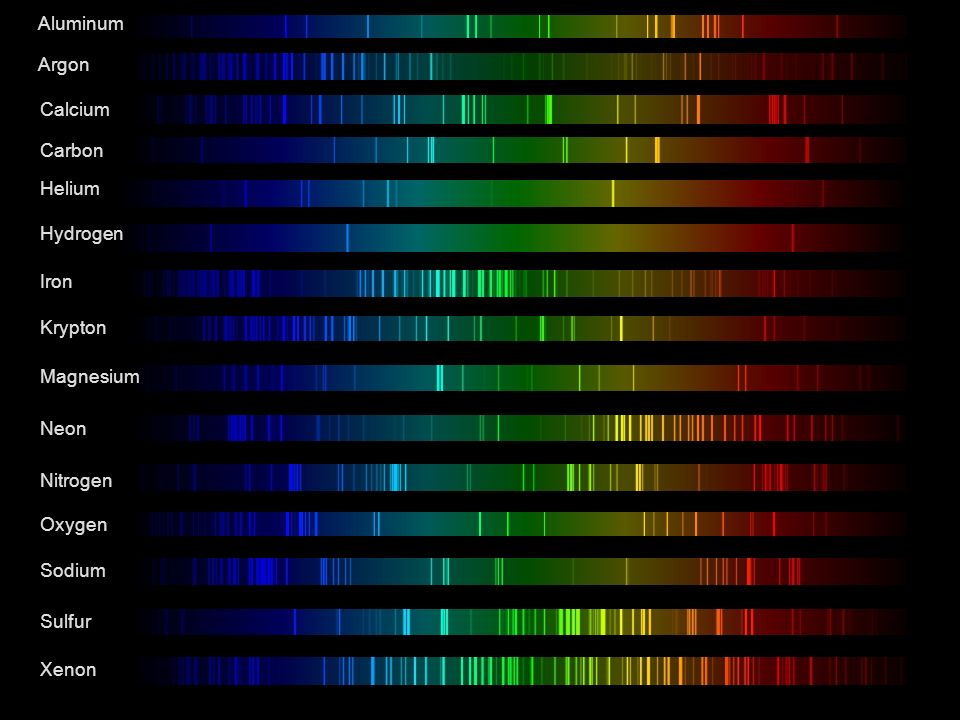 Lines of emission
Lines of emission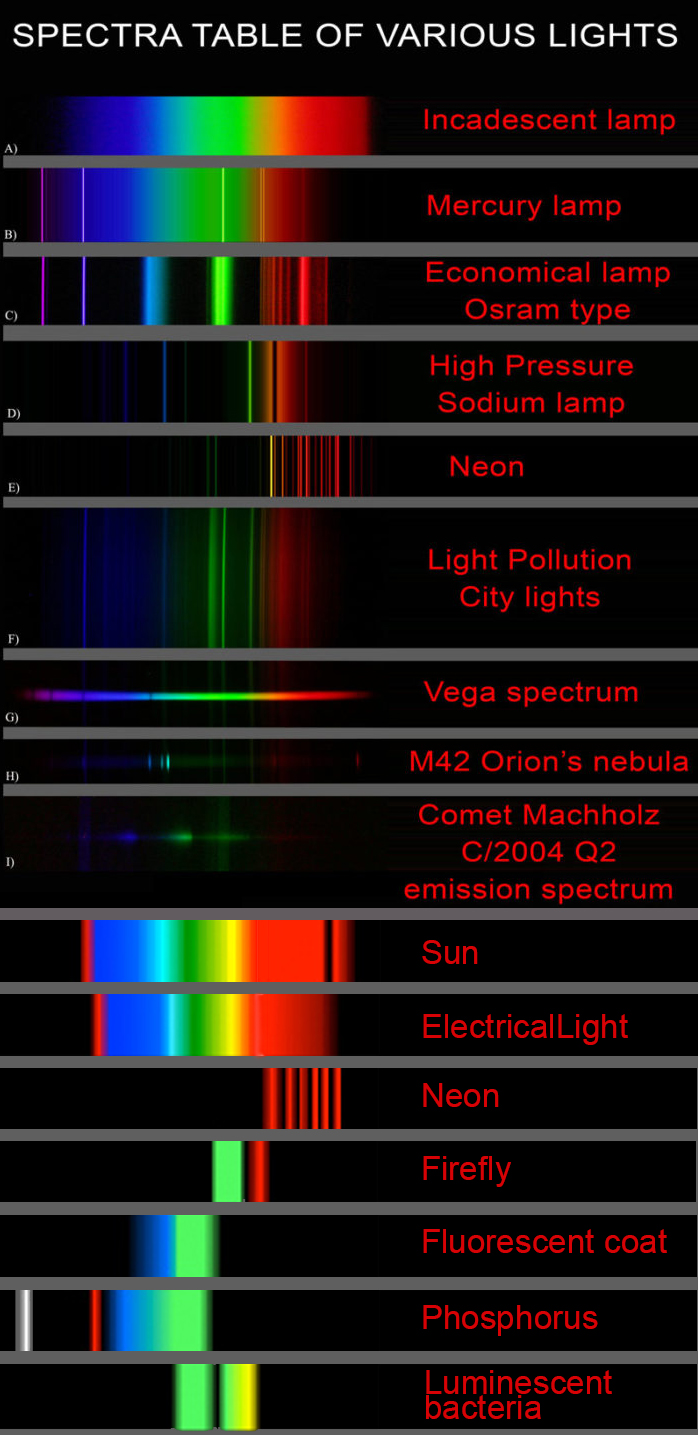
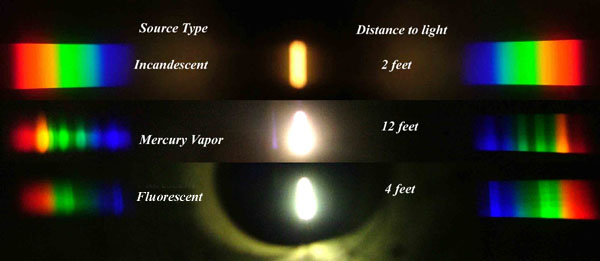
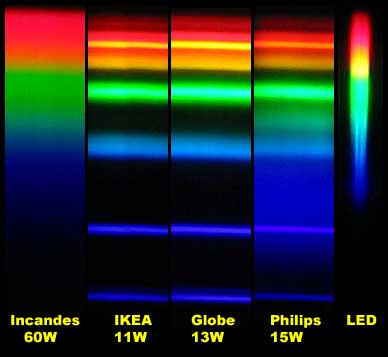
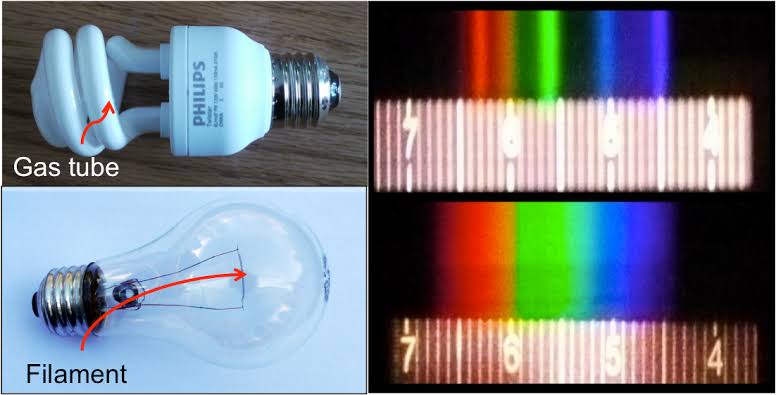
-
What light is best to illuminate gems for resale
www.palagems.com/gem-lighting2
Artificial light sources, not unlike the diverse phases of natural light, vary considerably in their properties. As a result, some lamps render an object’s color better than others do.
The most important criterion for assessing the color-rendering ability of any lamp is its spectral power distribution curve.
Natural daylight varies too much in strength and spectral composition to be taken seriously as a lighting standard for grading and dealing colored stones. For anything to be a standard, it must be constant in its properties, which natural light is not.
For dealers in particular to make the transition from natural light to an artificial light source, that source must offer:
1- A degree of illuminance at least as strong as the common phases of natural daylight.
2- Spectral properties identical or comparable to a phase of natural daylight.A source combining these two things makes gems appear much the same as when viewed under a given phase of natural light. From the viewpoint of many dealers, this corresponds to a naturalappearance.
The 6000° Kelvin xenon short-arc lamp appears closest to meeting the criteria for a standard light source. Besides the strong illuminance this lamp affords, its spectrum is very similar to CIE standard illuminants of similar color temperature.
-
What Is The Resolution and view coverage Of The human Eye. And what distance is TV at best?
https://www.discovery.com/science/mexapixels-in-human-eye
About 576 megapixels for the entire field of view.
Consider a view in front of you that is 90 degrees by 90 degrees, like looking through an open window at a scene. The number of pixels would be:
90 degrees * 60 arc-minutes/degree * 1/0.3 * 90 * 60 * 1/0.3 = 324,000,000 pixels (324 megapixels).At any one moment, you actually do not perceive that many pixels, but your eye moves around the scene to see all the detail you want. But the human eye really sees a larger field of view, close to 180 degrees. Let’s be conservative and use 120 degrees for the field of view. Then we would see:
120 * 120 * 60 * 60 / (0.3 * 0.3) = 576 megapixels.
Or.
7 megapixels for the 2 degree focus arc… + 1 megapixel for the rest.
https://clarkvision.com/articles/eye-resolution.html
Details in the post
-
-
Single vs Dual Processor Servers – CPUs, cores and threads
phoenixnap.com/kb/single-vs-dual-processors-server
The backbone of any server is the number of CPUs that will power it, as well as the actual model and the type of the CPU. From that point, you add the needed amount of RAM, storage and other options that your use case requires.
A CPU (Central Processing Unit) is a piece of hardware responsible for executing tasks from other parts of a computer.
A Core is a physical part of a CPU. Cores act like processors within a single CPU chip. The more cores a CPU has, the more tasks it can perform simultaneously. Virtually all modern CPUs contain multiple cores now. This enables the execution of multiple tasks at the same time.
Threads are like paths your computer can take to process information.
If a CPU has six cores with two threads per core, that means there are twelve paths for information to be processed. The main difference between threads and physical cores is that two threads cannot operate in parallel. While two physical cores can simultaneously perform two tasks, one core alternates between the threads. This happens fast so that it appears that true multitasking takes place. Threads basically help the cores process information in a more efficient manner. That being said, CPU threads bring actual, visible performance in very specific tasks, so a hyper-threaded CPU might not always help you achieve better results.Single processor servers run on a motherboard with one socket for a CPU. This means that the highest core count CPU available on the market determines the maximum core count per server. RAM capacity constraints with single CPU configurations remain one of their biggest drawbacks.
The most apparent distinction between single and dual-processor servers is that the motherboard has two CPU sockets instead of one. This is followed by additional benefits such as the massive amount of PCI lanes, two separate sets of cache memory and two sets of RAM slots. If the specific motherboard has 24 memory slots, 12 slots belong to the first CPU and the other 12 to the other CPU. In cases where only one CPU slot occupied, the CPU cannot use the other set of RAM sticks. This rarely happens since dual processor servers always have both slots occupied. Dual processor servers and multiprocessor systems, in general, are the best options for space-restricted environments.
While dual CPU setups pack enormous core counts and outshine single processor servers by a large margin, some tests have shown only a marginal performance increase over single CPU configurations with similar core count and clock speeds per chip. This refers to the circumstances where two CPUs worked on the same data at the same time.
On the other hand, we see immense performance boosts in dual processor servers when the workload is optimized for setups like these. This is especially true when CPUs carry out intensive multi-threaded tasks.
www.techsiting.com/cores-vs-threads/
-
Material X – an open standard for transfer of rich material and look-development content
MaterialX is an open standard for transfer of rich material and look-development content between applications and renderers.
Originated at Lucasfilm in 2012, MaterialX has been used by Industrial Light & Magic in feature films such as Star Wars: The Force Awakens and Rogue One: A Star Wars Story, and by ILMxLAB in real-time experiences such as Trials On Tatooine.
MaterialX addresses the need for a common, open standard to represent the data values and relationships required to transfer the complete look of a computer graphics model from one application or rendering platform to another, including shading networks, patterns and texturing, complex nested materials and geometric assignments.
To further encourage interchangeable CG look setups, MaterialX also defines a complete set of data creation and processing nodes with a precise mechanism for functional extensibility.
-
Open Source Nvidia Omniverse
blogs.nvidia.com/blog/2019/03/18/omniverse-collaboration-platform/
developer.nvidia.com/nvidia-omniverse
An open, Interactive 3D Design Collaboration Platform for Multi-Tool Workflows to simplify studio workflows for real-time graphics.
It supports Pixar’s Universal Scene Description technology for exchanging information about modeling, shading, animation, lighting, visual effects and rendering across multiple applications.
It also supports NVIDIA’s Material Definition Language, which allows artists to exchange information about surface materials across multiple tools.
With Omniverse, artists can see live updates made by other artists working in different applications. They can also see changes reflected in multiple tools at the same time.
For example an artist using Maya with a portal to Omniverse can collaborate with another artist using UE4 and both will see live updates of each others’ changes in their application.
-
Double Negative pulls plans of listing on Stock Exchange
DNEG said last month it was looking to raise £150m from a float on the LSE’s Main Market. This valued the firm at more than £600m.
But yesterday it said it has decided to postpone the listing due to ‘ongoing market uncertainty’.
The London-based group added that it had received ‘a strong level of interest from investors’ and still intends to go public once market conditions improve.
-
Magic Leap looking for 9th round of investments
Having burned through $2.6bn – that’s billion – on its way to producing an AR headset that has so many limitations it seemingly has zero chance of becoming a consumer device, the upstart has announced it is now part way through series E funding.
That’s just a Silicon Valley way of saying it’s on a fifth formal round of begging to banks and venture capitalists to help it keep going before the biz finally starts making money. In reality, it is the manufacturer’s eighth funding round, with the most recent being a cash influx of $280m in April this year. That money appears to be running out, or just simply not enough, just six months later.
www.theregister.co.uk/2019/11/14/magic_leap_imoney/
MagicLeap loses cfo Scott Henry and effects wizard John Gaeta following news of funding woes
-
MDL – NVidia Material Definition Language
www.nvidia.com/en-us/design-visualization/technologies/material-definition-language/
THE NVIDIA MATERIAL DEFINITION LANGUAGE (MDL) gives you the freedom to share physically based materials and lights between supporting applications.
For example, create an MDL material in an application like Allegorithmic Substance Designer, save it to your library, then use it in NVIDIA® Iray® or Chaos Group’s V-Ray, or any other supporting application.
Unlike a shading language that produces programs for a particular renderer, MDL materials define the behavior of light at a high level. Different renderers and tools interpret the light behavior and create the best possible image.
-
TERMINOLOGY USED on FILM SETS
www.ubcp.com/wp-content/uploads/Terminology-on-Film-Sets.pdf
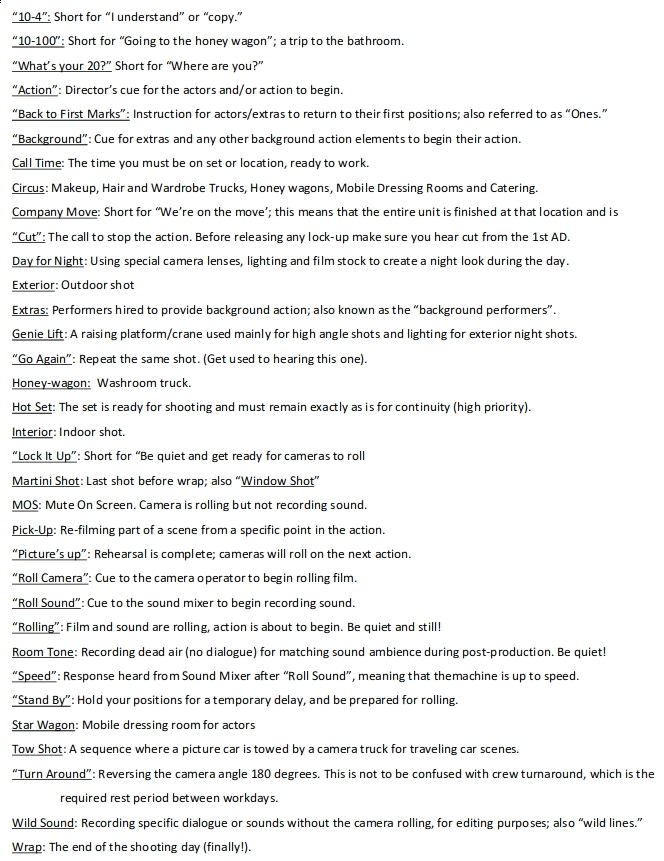
TERMINOLOGY USED on FILM SETS
“10-4”: Short for “I understand” or “copy.”
“10-100”: Short for “Going to the honey wagon”; a trip to the bathroom.
“What’s your 20?” Short for “Where are you?”
“Action”: Director’s cue for the actors and/or action to begin.
“Back to First Marks”: Instruction for actors/extras to return to their first positions; also referred to as “Ones.”
“Background”: Cue for extras and any other background action elements to begin their action.
Call Time: The time you must be on set or location, ready to work.
Circus: Makeup, Hair and Wardrobe Trucks, Honey wagons, Mobile Dressing Rooms and Catering.
Company Move: Short for “We’re on the move’; this means that the entire unit is finished at that location and is
“Cut”: The call to stop the action. Before releasing any lock-up make sure you hear cut from the 1st AD.
Day for Night: Using special camera lenses, lighting and film stock to create a night look during the day.
Exterior: Outdoor shot
Extras: Performers hired to provide background action; also known as the “background performers”.
Genie Lift: A raising platform/crane used mainly for high angle shots and lighting for exterior night shots.
“Go Again”: Repeat the same shot. (Get used to hearing this one).
Honey-wagon: Washroom truck.
Hot Set: The set is ready for shooting and must remain exactly as is for continuity (high priority).
Interior: Indoor shot.
“Lock It Up”: Short for “Be quiet and get ready for cameras to roll
Martini Shot: Last shot before wrap; also “Window Shot”
MOS: Mute On Screen. Camera is rolling but not recording sound.
Pick-Up: Re-filming part of a scene from a specific point in the action.
“Picture’s up”: Rehearsal is complete; cameras will roll on the next action.
“Roll Camera”: Cue to the camera operator to begin rolling film.
“Roll Sound”: Cue to the sound mixer to begin recording sound.
“Rolling”: Film and sound are rolling, action is about to begin. Be quiet and still!
Room Tone: Recording dead air (no dialogue) for matching sound ambience during post-production. Be quiet!
“Speed”: Response heard from Sound Mixer after “Roll Sound”, meaning that themachine is up to speed.
“Stand By”: Hold your positions for a temporary delay, and be prepared for rolling.
Star Wagon: Mobile dressing room for actors
Tow Shot: A sequence where a picture car is towed by a camera truck for traveling car scenes.
“Turn Around”: Reversing the camera angle 180 degrees. This is not to be confused with crew turnaround, which is the
required rest period between workdays.
Wild Sound: Recording specific dialogue or sounds without the camera rolling, for editing purposes; also “wild lines.”
Wrap: The end of the shooting day (finally!). -
Photography basics: How Exposure Stops (Aperture, Shutter Speed, and ISO) Affect Your Photos – cheat cards
Also see:
https://www.pixelsham.com/2018/11/22/exposure-value-measurements/
https://www.pixelsham.com/2016/03/03/f-stop-vs-t-stop/
An exposure stop is a unit measurement of Exposure as such it provides a universal linear scale to measure the increase and decrease in light, exposed to the image sensor, due to changes in shutter speed, iso and f-stop.
+-1 stop is a doubling or halving of the amount of light let in when taking a photo
1 EV (exposure value) is just another way to say one stop of exposure change.
https://www.photographymad.com/pages/view/what-is-a-stop-of-exposure-in-photography
Same applies to shutter speed, iso and aperture.
Doubling or halving your shutter speed produces an increase or decrease of 1 stop of exposure.
Doubling or halving your iso speed produces an increase or decrease of 1 stop of exposure.Details in the post
-
Joe Letteri on Production, VFX and storytelling
nerdist.com/article/joe-letteri-avatar-alita-battle-angel-james-cameron-martin-scorsese/
[Any] story [has to be] complete in itself. If there are gaps that you’re hoping will be filled in with visual effects, you’re likely to be disappointed. We can add ideas, we can help in whatever way that we can, but you want to make sure that when you read it, it reads well.
[Our responsibility as VFX artist] I think first and foremost [is] to engage the audience. Everything that we do has to be part of the audience wanting to sit there and watch that movie and see what happens next. And it’s a combination of things. It’s the drama of the characters. It’s maybe what you can do to a scene to make it compelling to look at, the realism that you might need to get people drawn into that moment. It could be any number of things, but it’s really about just making sure that you’re always in mind of how the audience is experiencing what they’re seeing.
COLLECTIONS
| Featured AI
| Design And Composition
| Explore posts
POPULAR SEARCHES
unreal | pipeline | virtual production | free | learn | photoshop | 360 | macro | google | nvidia | resolution | open source | hdri | real-time | photography basics | nuke
FEATURED POSTS
-
Kling 1.6 and competitors – advanced tests and comparisons
-
Mastering The Art Of Photography – PixelSham.com Photography Basics
-
Film Production walk-through – pipeline – I want to make a … movie
-
Top 3D Printing Website Resources
-
PixelSham – Introduction to Python 2022
-
Web vs Printing or digital RGB vs CMYK
-
Ross Pettit on The Agile Manager – How tech firms went for prioritizing cash flow instead of talent
-
The CG Career YouTube channel is live!
Social Links
DISCLAIMER – Links and images on this website may be protected by the respective owners’ copyright. All data submitted by users through this site shall be treated as freely available to share.
